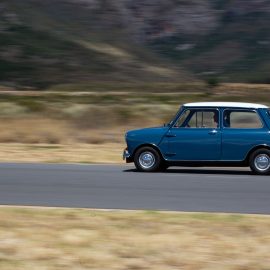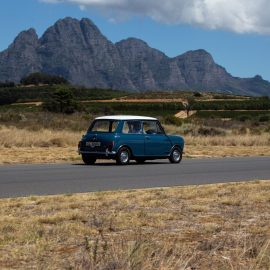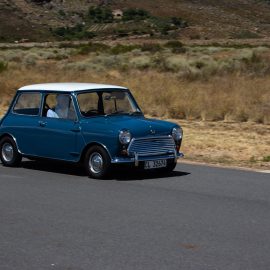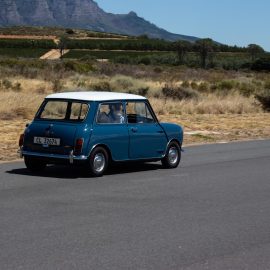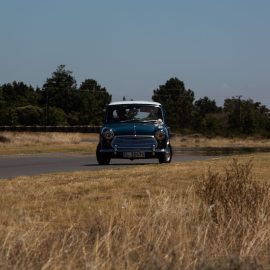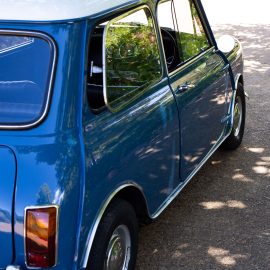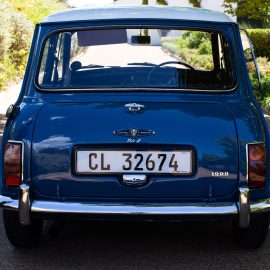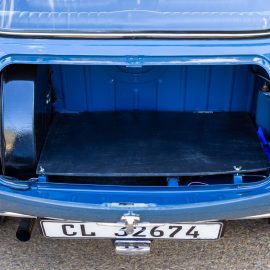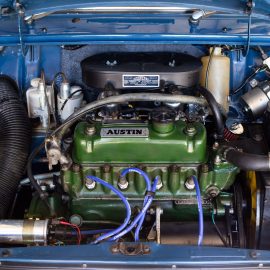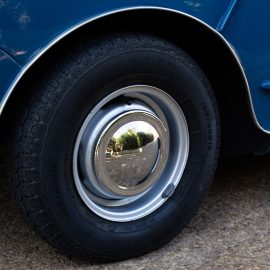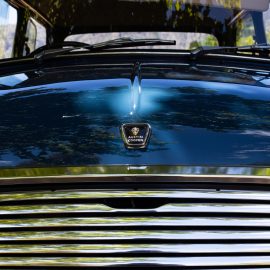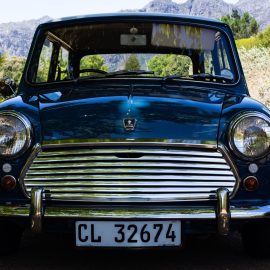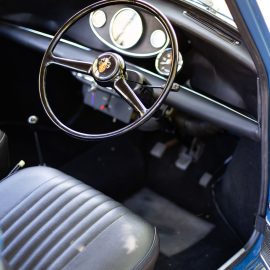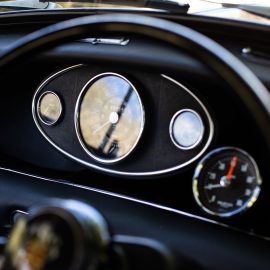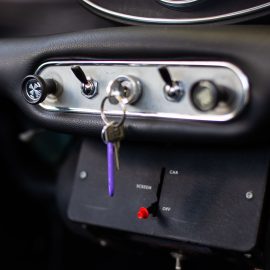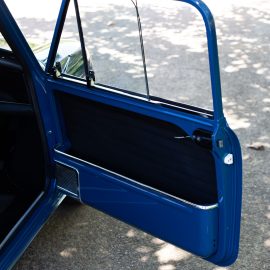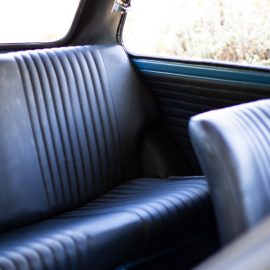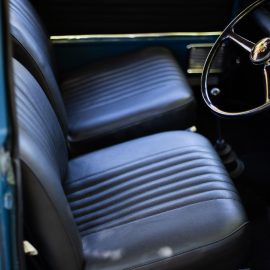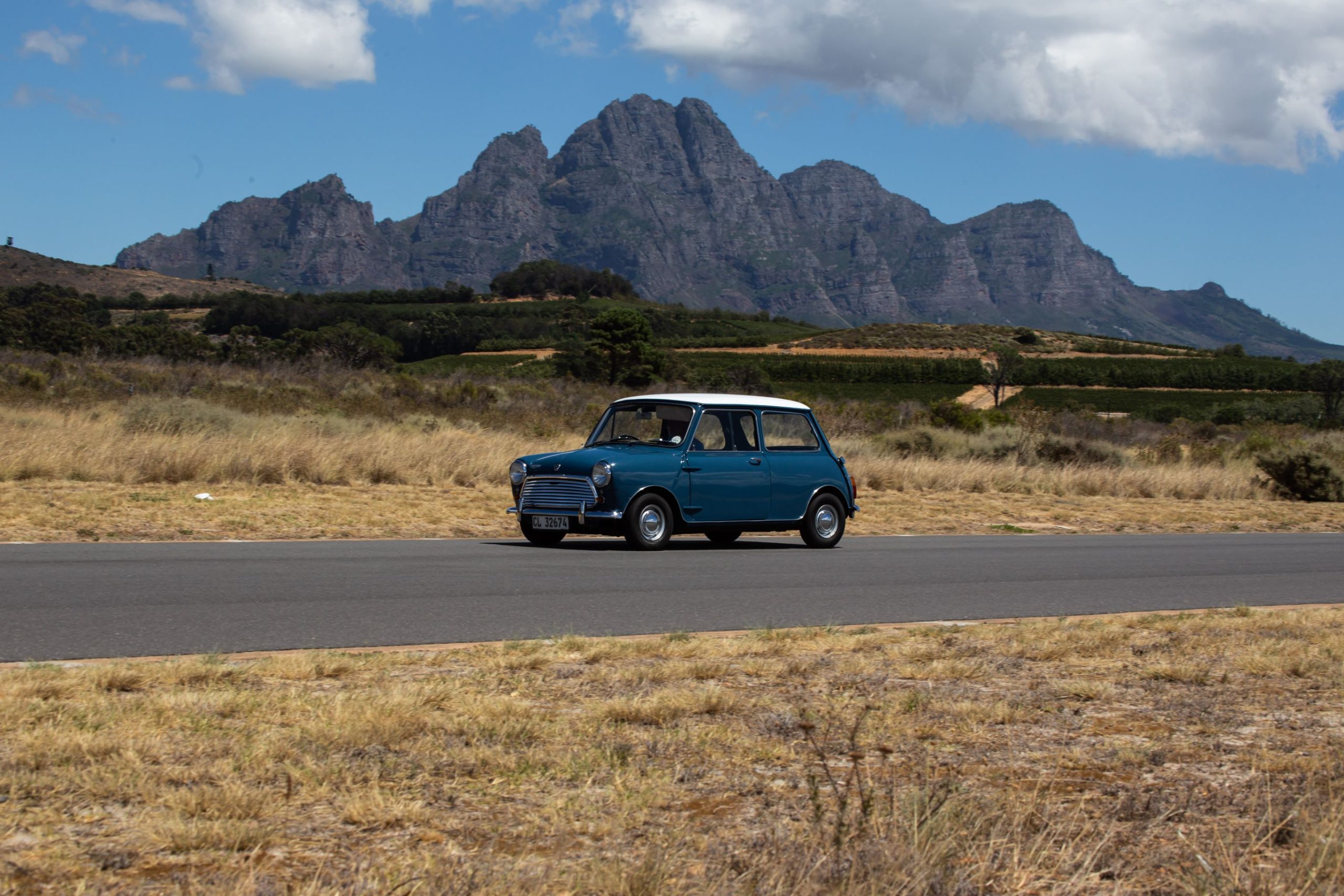
01 Mar Collection In Action: Austin Mini Cooper
Mike Monk has a sense of déjà vu behind the wheel of a rare-in-SA Mini Cooper…
The BMC Mini was a ground-breaking automobile. Designed by Alec (later Sir) Issigonis, it was developed as project ADO15 (ADO standing for Austin Design Office) and was introduced on 26 August 1959. In line with BMC’s badge engineering philosophy of the time, initially it was offered as an Austin Seven and Morris Mini Minor, and were built at Austin’s Longbridge plant and Morris’ Cowley factory. The names revived famous models from each company’s past, but the Morris was generally called simply Mini and in 1962 the Austin followed suit, before both cars were branded as Mini in 1969.
From then on, the Mini story grew and grew and rightfully earned iconic status in the vast world of automobiles. Its space-saving transverse engine and front-wheel drive layout – allowing 80% of the area of the car’s floorpan to be used for passengers and luggage – influenced a generation of car makers. Sliding windows allowed single-skin doors to be fitted, improving elbow room and reducing costs. The Mini featured a number of design innovations, including anengine-oil lubricated, four-speed transmission located in the sump, and a side-mounted radiator. The suspension system, designed by Issigonis’ friend Dr Alex Moulton, used compact rubber cones instead of conventional springs. In 1964 this set-up was modified with a Hydrolastic system that replaced the separate springs and dampers with fluid-filled displacer units interconnected between the front and rear wheels on each side of the vehicle. Ten-inch (254 mm) wheels were specified, so new tyres had to be developed, the initial contract going to Dunlop. In 1959, BMC and Alec Issigonis won the Dewar Trophy, for the design and production of the Mini.
The story of the Mini would take many newsletters to cover thoroughly, but it is one particular offshoot of the car’s development that is the subject of this month’s Collection In Action. But first, some background information is necessary. Issigonis’ friend John Cooper, owner of the Cooper Car Company and designer and builder of Formula 1 cars, saw the potential of the Mini for competition. Issigonis was initially reluctant to see the Mini in the role of a performance car, but after John Cooper appealed to BMC management, the two men collaborated to create the Mini Cooper. The Austin Mini Cooper and Morris Mini Cooper debuted in September 1961.
The standard Mini’s 848cc engine was given a longer stroke to increase capacity to 997cc, increasing power from 25 to 41 kW. The car featured a race-tuned engine, twin SU HS2 carburettors, a close-ratio gearbox and front (Lockheed) disc brakes, uncommon at the time in a small car. One thousand units of this version were commissioned by management, intended for and designed to meet the homologation rules of Group 2 rallying. Naturally, the car was raced too, and in 1962 Rhodesian John Love became the first non-British racing driver to win the British Saloon Car Championship driving a Mini Cooper. South African Tony Maggs was a works Cooper driver.
From then on, the lineage of the Mini Cooper gets a bit complicated. First, in 1963 the Cooper’s 997cc engine was replaced by a 998cc while a more powerful 1 071cc Mini Cooper, dubbed the S, was introduced. Two other S models were developed specifically for circuit racing in the under-1 000cc and under-1 300cc classes, rated at 970cc and a 1 275cc respectively, and both were also offered to the public. From 1965 twin fuel tanks were standard on Cooper S models and optional on the 1 071cc. The Mini Cooper and Cooper S were certainly successful in both racing and rallying, famously winning the Monte Carlo Rally in 1964, 1965, and 1967. In 1966, the first-placed Mini (along with nine other cars) was disqualified after the finish, under a controversial decision that the car’s headlights were against the rules. This decision prevented what would have been a hat-trick of Mini victories.
South Africa was one of numerous countries around the world where BMC had manufacturing/assembly plants and the Mini Cooper was assembled from CKD (Completely Knocked Down) kits at the production facility located in Blackheath in Cape Town. Only the 997cc, 1 071cc and 1 275cc Coopers were manufactured in South Africa, which – at last! – leads us to the car featured here.
The Mk.II Mini was launched at the 1967 British Motor Show, and featured a redesigned grille, a larger rear window, bigger tail-lights and numerous cosmetic changes. FMM’s blue Cooper is in excellent condition and its engine number 9FD –XE H1108 confirms it as being a UK-assembled Cooper Mk.II with a 998cc engine. The car’s VIN number identifies it as being a 1968 model produced at the Cowley factory, even though it is badged as an Austin. British Heritage Foundation production records confirm that no CKD 998cc Coopers were shipped to SA, so this particular car was most probably a direct import (possibly from the then Rhodesia when Minis were also assembled) and is therefore a rarity in this country. It was kindly donated to FMM by Daniel Prins, a keen supporter of the museum, in September last year, who has also donated a couple of BMW motorcycles to the collection.
BMC SA did introduce a Mini 1000 in January 1966 and a Mini 1000 S in December 1967 both with a 998cc engine, but neither were Cooper spec. So in its performance guise, the BMC A-Series 998cc engine had a bore of 64,59 mm and a stroke of 76,2 mm. In Cooper guise with its twin SU carbs and 9,0:1 compression ratio, it produced 41 kW at 5 800 r/min and 77,3 N.m of torque at 3 000. Performance figures of the time suggested a 0-60 mph (96 km/h) time of around 15 seconds and a top speed of 88 mph (141,6 km/h). Oh, and a relatively good fuel economy of 32 mpg (8,8 litres/100 km).
Having worked in product development for a period back in the 1970s for Leyland (which is what BMC became) in South Africa, I was involved in a number of Mini projects, so there was a sense of déjà vu climbing into FMM’s super Cooper. Even my long-legged frame manages to get comfy inside, the basic front bucket seats being more comfy than they look. It never ceases to amaze just how roomy these tiny cars are, being just 3,05 metres long, 1,41 m wide and 1,35 m high. Capable of carrying four adults and some luggage, the Mini set a benchmark for small car packaging. But this model’s sportier exhaust gives a clue to its Cooper heritage, and it does not fail to bring some sporty feel to travelling.
Given the freedom of the L’Ormarins PlaasPad, the car was a bundle of fun to drive. The pedals are well placed and the simple, plastic, two-spoke steering wheel is easy to twirl. An aftermarket rev counter sits in the full-width parcel tray, but otherwise the interior is stock standard. While not super fast along the straight sections of the track, the experience of buzzing along with an uninterrupted view of the Franschhoek Valley playing out to the soundtrack of the lively engine’s exhaust was smile-inducing all the way. Through the twistier sections there was hardly any need to brake or lift off, the Mini’s legendary kart-like handling rising to the fore. The old hard tyres squealed a bit but I took it as squeals of excitement rather than protest. Visions sprang to mind of Minis racing in their heyday against much bigger and more powerful machinery, losing out down the straights but doing a David versus Goliath act through the corners. Magic memories…
Total production of the Mini Cooper Mk.II with 998cc engines was 16 000 of which approximately 290 made their way to SA, around two-thirds being badged as Austins. The model had a production life of 15 months before being replaced by the 1 071 Cooper S in July 1964. As mentioned earlier, FMM’s car is in excellent shape and drew plenty of admiring glances while on the museum’s display at the West Coast Car Show in January. There is little to distinguish between the various Mini derivatives of the time, so this car’s rarity value goes unnoticed to all but the marque’s aficionados. In 1999, the Mini was voted the second-most influential car of the 20th century behind the Ford Model T, and FMM is proud to have this super Cooper as part of its collection.
(Sincere thanks go to Ryno Verster and his book, ‘A South African Mini Story’, for supplying valuable details included in this story.)




